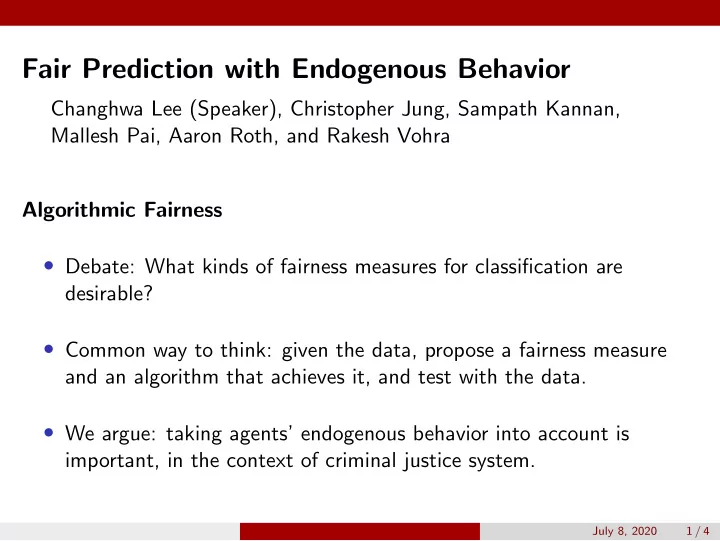

Fair Prediction with Endogenous Behavior Changhwa Lee (Speaker), Christopher Jung, Sampath Kannan, Mallesh Pai, Aaron Roth, and Rakesh Vohra Algorithmic Fairness • Debate: What kinds of fairness measures for classification are desirable? • Common way to think: given the data, propose a fairness measure and an algorithm that achieves it, and test with the data. • We argue: taking agents’ endogenous behavior into account is important, in the context of criminal justice system. July 8, 2020 1 / 4
What we do Model Agents from different groups decide whether to commit a crime or not, by comparing payoffs of crime and probability of being classified as guilty. Judge designs a classification rule to minimize the average crime rate. Crime Minimizing Classification Crime-minimizing classification maximizes disincentive to commit a crime. July 8, 2020 2 / 4
Properties of Crime Minimizing Classification Crime Minimizing Classification 1. Crime-minimizing classification only cares about giving the right incentive to induce the right behavior. 2. Fair in equalizing: false positive rates, false negative rates and disincentives. 3. Incompatible with: equalizing posterior risk thresholds, equalizing positive / negative parity rates. July 8, 2020 3 / 4
Robustness That the incentive is the only thing that matters is robust: • Agents may have different costs and rewards for crime. • Agents may not behave perfectly rationally and pick (e.g.) a random action with some probability q i • Signals may be observed at different rates across the groups. • If the signal distributions differ by group, for a large class of signal structures, equalizing disincentives ∆ g is the only fairness notion that is compatible with the crime-minimizing classification. Takeaway: Incentives matter! July 8, 2020 4 / 4
Recommend
More recommend